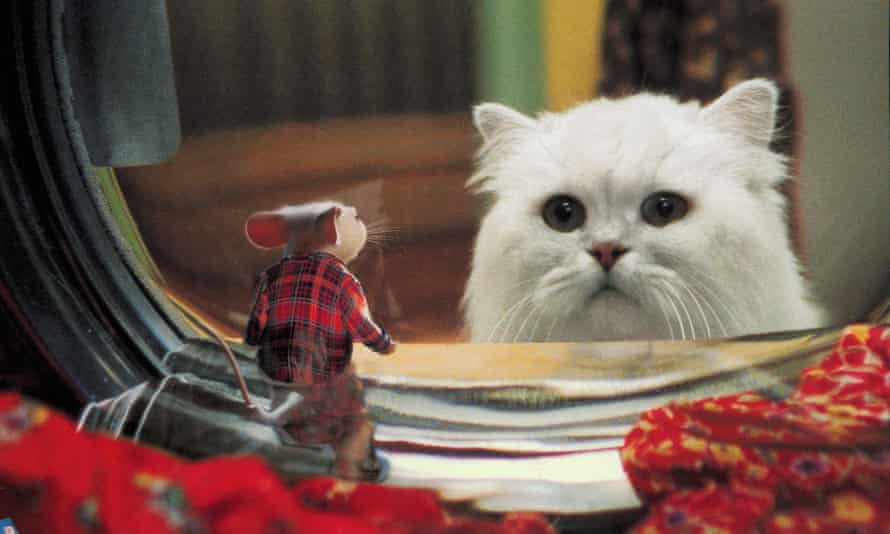Cats have been effortlessly stealing scenes from their human co-stars for decades. Who could forget Audrey Hepburn’s adorable marmalade tabby in Breakfast at Tiffany’s? Or Jinx, the toilet-flushing Himalayan in Meet the Parents? Behind every famous film cat, there is a dedicated trainer patiently teaching them to obey a command, making sure they’re happy on set, and grooming them fastidiously to maintain their fluffy good looks.
The film-makers behind The Electrical Life of Louis Wain, a British period biopic about the Edwardian artist and illustrator who became famous for his surreal portraits of cats, were adamant they didn’t want to use CGI for the shoot, so animal trainer Charlotte Wilde was brought in with 40 feisty felines. “It was organised chaos,” she says. “They had their own green room and were treated like royalty.”
Wilde, who has also worked on Fighting With My Family and Bohemian Rhapsody, runs a London agency that provides animals for film and TV. Felix, her 10-year-old black and white moggie (“a very cheeky chap!”), was cast as Peter, Wain’s furry best friend, who inspires his first sketches.
Cats, of course, are notoriously fickle and independent – but that doesn’t mean they can’t be trained like dogs to behave and do tricks on screen. Wilde says she uses positive reinforcement with plenty of snacks on hand to dish out as rewards. “We teach our cats to go to mark,” she says. “They’ll walk in and they’ll know where to stop. We train them so they run to the sound of a buzzer. We’ve got some that can roll over. A couple can retrieve. They’ll lie down, rub against people’s legs, walk alongside someone. We show them what they’ve got to do. Then we try to make that happen on the take.”

A clicker is used as encouragement. “You might have a moment in between a couple of lines where we can get a click in, just so the cat [knows]: ‘You’re doing really well. Wait. Food is coming.’ Obviously, that’s really distracting for actors. They’re probably sick of the sound of a clicker by the end of the film!”
Mark Harden, an animal trainer based in Los Angeles, was in charge of the five snowy white Chinchilla Persians who played Snowbell in Stuart Little, and looked after 40 cats on the set of Catwoman including several rare Egyptian Maus. With cats, he says, it’s all about getting into their mindset. “They’re a predator but they can also be skittish. They’ve got a very strong flight reaction. The most important thing with a cat is desensitising them to strange environments. A movie set is a very strange environment.”

Canadian animal trainer Melissa Millett has a novel way of desensitising the cats she works with: she stages mock film shoots at home. For the Pet Sematary reboot, she recruited five Maine Coons from rescue shelters to play Church, in the Pet Sematary reboot, who is transformed into an aggressive zombie cat. This meant gradually acclimatising them to wearing makeup and being wet. The whole process took two months. “We started with a catnip party in the bathtub. A little bit of water on the cat while it’s eating. Then we worked up to a full bath. Separately, we would start with a bit of egg white and then work our way up. All the products had to be edible.”
Expectations for cat actors tend to be much lower than for dogs, says Harden. “People are more in awe of you when you have a good working cat. I guess they expect the cat to be scared.” Even so, animal trainers can teach cats to do the kind of tricks that would easily outshine Lassie. Millett has a talented Bengal named Sashimi, who can ride a scooter. Wilde taught one of her moggies, Leicester, to pretend to play the harmonica, while Harden trained Cairo, an Egyptian Mau, to pick up a mobile phone with his teeth and run off with it.
But it’s not all cats being cute and cuddly on cue. Being bitten accidentally is an occupational hazard. Then there’s the cat hair that gets everywhere. “You certainly don’t wear your best clothes to work!” says Wilde. “You have to get up extra early because you’ve got to get the animals ready. You go to bed later because you’ve got to put them to bed. They come first no matter what. I’d say it’s a way of life rather than a job. It’s incredibly rewarding. They give you so much.”
Post a Comment